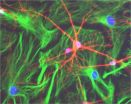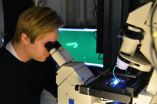(Press-News.org) VIDEO:
Karen Tashima, MD, director of the HIV Clinical Trials Program at The Miriam Hospital, led a study to look at new treatment regimens for patients with drug-resistant HIV.
...
Click here for more information.
PROVIDENCE, R.I. – A new multi-site study reveals patients with drug-resistant HIV can safely achieve viral suppression – the primary goal of HIV therapy – without incorporating the traditional class of HIV medications into their treatment regimen. Karen Tashima, M.D., director of the HIV Clinical Trials Program at The Miriam Hospital, served as study chair.
The AIDS Clinical Trials Group (ACTG) Network's OPTIONS Trial proves, for the first time, that treatment-experienced patients can leave out this class of medication, known as nucleoside reverse transcriptase inhibitors (NRTI), as part of the regimen. These results could change treatment guidelines, lessen side effects and increase adherence rates, the researchers say.
Tashima and colleagues presented the results from the 48-week study at the annual Conference for Retroviruses and Opportunistic Infections (CROI) in Atlanta on March 6.
"We are so comfortable clinically with the NRTI class that we think we must always use at least one drug from this class in treatment. However, some patients have developed within-class resistance, making the NRTIs less effective overall. Therefore, drugs from this class may not be needed if the new treatment plan contains more effective medications," said Tashima, who also leads ACTG's clinical research site at The Miriam Hospital.
"There were a few new drugs coming out at the same time and we decided to turn the question around. Instead of having patients take their current medications from the NRTI class as well as these new drugs from different classes, we asked half of the study participants to add NRTIs and half of them to leave out NRTIs from their new treatment plan. We were able to take the usual study paradigm and turn it around," she added.
Treatment-experienced patients can develop resistance to therapy due to poor adherence, said Richard Haubrich, M.D., the study's co-chair and professor of medicine at University of California at San Diego. Designing a treatment plan using new drugs from new classes and omitting NRTIs leads to fewer pills, and hopefully, better adherence.
"There are several options for treatment naïve patients, but not as many for treatment-experienced. The HIV research field accepted that nucleosides would be an important component for multiple class-experienced patients," said Haubrich. "However, our results were very clear. We can safely exclude NRTIs, giving physicians a new paradigm for ART prescription in clinic and potentially changing treatment guidelines."
To ensure eliminating NRTIs from their treatment regimen would not be detrimental for viral suppression, investigators used a web utility to review each of the 413 study participants' study records to determine optimal treatment plans. This tool allowed all of the study's investigators to consult together on each study participant, offering the best plan for treatment.
The OPTIONS Trial, also called A5241, included ACTG sites from around the country as well as sites from the International Maternal Pediatric Adolescent AIDS Clinical Trials group and the Adolescent Medicine Trials Network. Study volunteers needed to be at least 16 years old and show treatment experience or resistance to their current HIV medications. Most of the A5241 participants had been on ART for 10 years or more.
Traditional antiretroviral therapy consists of medications from the nucleoside reverse transcriptase inhibitor class, including tenofovir, azidothymidine and lamivudine. The new medications studied included darunavir and tipranavir from the protease inhibitor class of HIV medications, maraviroc from the CCR5 antagonist class, raltegravir from the integrase inhibitor class, etravirine from the non-nucleoside reverse transcriptase inhibitors class and enfuvirtide an injectable drug from the fusion inhibitor class.
Patients will continue on study for a total of 96 weeks to ensure virologic suppression is maintained.
"There is no question that the results show what we had set out to prove – a treatment-experienced patient will not lose virologic suppression by omitting NRTIs," said Tashima. "We are so excited to show this data."
###
This research was supported by the U.S. Department of Health and Human Services (DHHS), the National Institutes of Health (NIH), the National Institute of Allergy and Infectious Diseases (NIAID) and the Division of AIDS (DAIDS) under awards 5U01AI069472 and UM1-A1068636.
The principal affiliation of Karen Tashima, M.D., is The Miriam Hospital (a member hospital of the Lifespan health system in Rhode Island). Tashima is also a professor of medicine at The Warren Alpert Medical School of Brown University.
The AIDS Clinical Trials Group (ACTG) Network's Leadership and Operations Center (LOC) is based at Brigham and Women's Hospital in Boston. The ACTG Network's mission is to develop and conduct scientifically rigorous translational research and clinical trials to (1) investigate the viral and immune pathogenesis of HIV-1 infection and its complications; (2) evaluate novel drugs and strategies for treating HIV-1 infection; (3) evaluate interventions and strategies to treat and prevent HIV-related co-infections and co-morbidity, and; (4) publish and disseminate results to improve care, and reduce or eliminate morbidity and mortality associated with HIV-1 infection and its complications. The Network has 73 research sites around the world, including 50 domestically and 23 abroad.
The Miriam Hospital is a 247-bed, not-for-profit teaching hospital affiliated with The Warren Alpert Medical School of Brown University. It offers expertise in cardiology, oncology, orthopedics, men's health, and minimally invasive surgery and is home to the state's first Joint Commission-certified Stroke Center and robotic surgery program. The hospital is nationally known for its HIV/AIDS and behavioral and preventive medicine research, including weight control, physical activity and smoking cessation. The Miriam Hospital has been awarded Magnet Recognition for Excellence in Nursing Services four consecutive times and is a founding member of the Lifespan health system. Follow us on Facebook and on Twitter (@MiriamHospital). END
HIV therapy just got easier: Fewer drugs may be needed for treatment-experienced patients
Multi-site study, led by a Miriam Hospital researcher, could change treatment strategy for these patients
2013-03-07
ELSE PRESS RELEASES FROM THIS DATE:
Majority of Albertans support assisted suicide: UAlberta study
2013-03-07
(Edmonton) An overwhelming majority of Albertans believe dying adults should have the right to request to end their life, according to new research from the University of Alberta.
U of A researcher Donna Wilson led the team that studied the views of 1,203 Albertans on assisted suicide, currently illegal in Canada. A majority—77.4 per cent—felt dying adults should have the right to end their life early.
"Increasingly, there are countries or states where they are allowing assisted suicide or euthanasia. Like many of those countries, Canada will have to grapple with this ...
UTHealth researchers find industrial chemicals in food samples
2013-03-07
HOUSTON – (March 6, 2013) – Researchers at The University of Texas Health Science Center at Houston (UTHealth) have discovered phthalates, industrial chemicals, in common foods purchased in the United States. Phthalates can be found in a variety of products and food packaging material, child-care articles and medical devices.
"Although it's not completely understood how phthalates get into our food, packaging may be a contributor to the levels of the toxin in food," said lead investigator Arnold Schecter, M.D., M.P.H., professor of environmental health at The University ...
A new cryptic spider species from Africa
2013-03-07
The species from the genus Copa are very common spiders found in the leaf litter of various habitats. Being predominantly ground-living, they occur widely in savanna woodlands but also occasionally in forests, where they are well camouflaged. They usually share the litter microhabitats with several other species of the family Corinnidae. The spiders from this cryptic, ground-dwelling genus in the continental Afrotropical Region are revised in a study published in the open access journal Zookeys.
The number of continental species in the Afrotropical Region has been reduced ...
How to predict the progress of technology
2013-03-07
CAMBRIDGE, MA -- Researchers at MIT and the Santa Fe Institute have found that some widely used formulas for predicting how rapidly technology will advance — notably, Moore's Law and Wright's Law — offer superior approximations of the pace of technological progress. The new research is the first to directly compare the different approaches in a quantitative way, using an extensive database of past performance from many different industries.
Some of the results were surprising, says Jessika Trancik, an assistant professor of engineering systems at MIT. The findings could ...
Iowa State engineers developing ideas, technologies to save the Earth from asteroids
2013-03-07
AMES, Iowa – Bong Wie has heard the snickers.
You want to protect the Earth from asteroids? Where were you when the dinosaurs needed you? You want to be like Bruce Willis in that asteroid movie?
Wie has a serious reply: After five years of science and engineering work, Wie and his small team have a publication list of 40-plus technical papers, $600,000 of NASA research support and a proposal for a $500 million test launch of an asteroid intercept system. Plus, Wie has just been invited to show off his research as part of NASA's Technology Day on the Hill in Washington, ...
INRS overcomes a hurdle in the development of terahertz lasers
2013-03-07
This press release is available in French.
Dr. Roberto Morandotti and his team at the INRS Énergie Matériaux Télécommunications Research Centre have developed a device that is critical to the use of terahertz (THz) sources for a variety of applications. Their electromagnetic non-reciprocal isolator is the subject of a recent article in Nature Communications, showing just how important this new development is. Until now, no isolator existed that was effective in the THz region of the spectrum, a situation that held back the development of certain technologies. The new ...
Star-shaped glial cells act as the brain's 'motherboard'
2013-03-07
The transistors and wires that power our electronic devices need to be mounted on a base material known as a "motherboard." Our human brain is not so different — neurons, the cells that transmit electrical and chemical signals, are connected to one another through synapses, similar to transistors and wires, and they need a base material too.
But the cells serving that function in the brain may have other functions as well. PhD student Maurizio De Pittà of Tel Aviv University's Schools of Physics and Astronomy and Electrical Engineering says that astrocytes, the star-shaped ...
Ketchup turns somersaults
2013-03-07
This press release is available in German.
The unusual behavior of complex fluids is part of our daily life: cake dough climbs up the stirring bar, ketchup becomes liquid when you shake it. Also technology uses such phenomena: if we add a small amount of long-chained polymer molecules, a pipeline can transport more oil. The polymers reduce the flow resistance. But up to now the origin of these effects was unclear. The engineers had to rely on estimates and lengthy trials.
A team of physicists led by Professor Andreas Bausch, Chair of Cellular Biophysics at TUM now ...
Mayo Clinic aids discovery of first dystonia gene found in African-Americans
2013-03-07
JACKSONVILLE, Fla. — A pair of studies tells the tale of how a neuroscientist at Mayo Clinic in Florida helped to discover the first African-American family to have inherited the rare movement disorder dystonia, which causes repetitive muscle contractions and twisting, resulting in abnormal posture. The research may improve diagnosis of this neurological condition in a population not known to suffer from it.
In the first study, published in 2011 in the journal Parkinsonism and Related Disorders, Mayo Clinic's Zbigniew Wszolek, M.D., and a team of neuroscientists from ...
Federal figures miss most work-related amputations
2013-03-07
A new report from Michigan State University and the Michigan Department of Community Health raises significant concerns about the federal government's system for tracking work-related injuries.
Published in the Journal of Occupational and Environmental Medicine, the study found the number of amputations following jobsite accidents in Michigan was nearly two-and-a-half times higher than the official estimate from the U.S. Bureau of Labor Statistics.
Such inaccuracy is evidence that the bureau should change its system that relies solely on a sample of employers to report ...
LAST 30 PRESS RELEASES:
Membrane magic: FAMU-FSU researchers repurpose fuel cells membranes for new applications
UN Member States pledge to increase access to diagnosis and inhaled medicines for the 480 million people living with COPD
Combination therapy shows potential to treat pediatric brain cancer ATRT
Study links seabird nesting to shark turf wars in Hawai‘i
Legal sports betting linked to sharp increases in violent crime, study finds
Breakthrough AI from NYUAD speeds up discovery of life-supporting microbes
New Eva Mayr-Stihl Foundation funding initiative boosts research at University of Freiburg on adaptation of forests to global change
The perfect plastic? Plant-based, fully saltwater degradable, zero microplastics
Bias in data may be blocking AI’s potential to combat antibiotic resistance
Article-level metrics would provide more recognition to most researchers than journal-level metrics
Satiety’s little helper: Protein that supports appetite regulating protein identified
UF dives deep into predicting storm damage with computer models
A stormy ocean voyage yields insights on the global carbon cycle
Scientists identify first non-coding gene that controls cell size
Demonstration of altermagnetism in RuO₂ thin films -- A new magnetic material for the AI era
Penn researchers awarded $25M to conduct trial using smartphones to fight heart disease
PCORI awards funding for new patient-centered healthcare research
Exploring the origins of the universe: 145 low-noise amplifiers complete ALMA telescopes
Empress cicada wings help illuminate molecular structure
Using sound waves to detect helium
Time burden in patients with metastatic breast and ovarian cancer from clinic and home demands
Researchers discover bias in AI models that analyze pathology samples
Scientists ID potential way to prevent brain injuries from triggering Alzheimer's
MASTER 2nd Open Call: Execution period kick-off
Algae for health in food and pharma
Advanced microrobots driven by acoustic and magnetic fields for biomedical applications
Chicago health information leader recognized for raising CPR readiness and blood pressure awareness
The Intimate Animal, a new book from Kinsey Institute Executive Director Dr. Justin Garcia
When blue-collar workers lose union protection, they try self-employment
New video dataset to advance AI for health care
[Press-News.org] HIV therapy just got easier: Fewer drugs may be needed for treatment-experienced patientsMulti-site study, led by a Miriam Hospital researcher, could change treatment strategy for these patients



